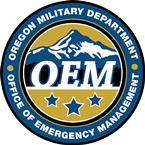|
OSSPAC
|

|
|
|
|
|
Article Content
The Oregon Seismic Safety Policy Advisory Commission (OSSPAC), otherwise known as the Earthquake Commission, has the unique task of promoting earthquake awareness and preparedness through education, research, and legislation. The mission of OSSPAC positively influence decisions and policies regarding pre-disaster mitigation of earthquake and tsunami hazards, increase public understanding of hazard, risk, exposure, and vulnerability through education seminars, etc., and be responsive to the new studies and/or issues raised around earthquakes and tsunamis. In order to fulfill the goals of the commission, OSSPAC members have developed five primary objectives. These objectives are to increase or improve: - earthquake awareness, education, and preparedness,
- earthquake risk information,
- the earthquake safety of buildings and lifelines,
- geoscience and technical information, and
- emergency pre-disaster planning, response and recovery efforts.
OSSPAC is a well-rounded group of 18 individuals who represent a variety of interests concerned with the formulation of public policy regarding earthquakes. It is made up of six representatives of government, six representatives of the public interest, and six representatives of industries and stakeholders. This variety of interests helps direct the goals of the Commission for the benefit of all Oregon citizens.
Back to Top
As a result of the Loma Prieta Earthquake in the Bay Area of California in 1989, Oregon residents wanted the State government to address the earthquake hazard and preparedness of the State. As a result, the Interagency Seismic Task Force recommended that a new state commission be formed in response to this need. OSSPAC was formed as a result of Senate Bill 96 in 1991. Since this time, OSSPAC has continued to increase Oregon ’s awareness to earthquake hazards by supporting earthquake education, research, and legislation. Every two years, OSSPAC provides a summary report to the Governor of the Commission's activities. OSSPAC has also formed relationships with the Western States Seismic Policy Council (WSSPC) and the California Seismic Safety Commission which provides a persuasive advantage to affect federal policy for the West Coast.
Back to Top
The mission of the Oregon Seismic Safety Policy Advisory Commission (OSSPAC) is described in the Oregon Revised Statutes (ORS, 2009 edition), Section 401.918: http://www.oregonlaws.org/ors/401.915 (1) The mission of the Oregon Seismic Safety Policy Advisory Commission shall be to reduce exposure to earthquake hazards in Oregon by: (a) Developing and influencing policy at the federal, state and local levels;
(b) Facilitating improved public understanding and encouraging identification of
risk;
(c) Supporting research and special studies;
(d) Supporting appropriate mitigation;
(e) Supporting response and recovery; and
(f) Supporting and assisting in the coordination of a grant program for the
disbursement of funds for seismic rehabilitation of schools and emergency
facilities.
(2) The commission shall utilize and influence existing agencies and institutions in meeting its goals and is in no way intended to replace or compete with existing authorities relative to earthquakes. Emphasis shall be on coordination and linking of existing resources and authorities. (3) To improve public understanding of earthquake hazards, reduce such hazards and mitigate the possible effects of potentially damaging earthquakes, the commission shall review and advise the Governor and the Legislative Assembly concerning all plans and proposals addressing seismic hazards in the areas of: (a) Any legislative proposals
(b) Plans and proposals of statewide impact
(c) Lists of recommendations for actions and potential rule changes specifically
by state agency
Back to Top
CHAIR: Jay Wilson - Public member
VICE CHAIR: Jay Raskin - Public Member
Doug Dougherty - Schools Stakeholder
Greg Ek-Collins - Oregon Department of Transportation
Paul Evans - Representative, Legislative Assembly
Steve Lucker - Department of Land Conservation & Development
Ed MacMullan - Banking Stakeholder
Ian Madin - Department of Geology and Mineral Industries
Walter McMonies - Multifamily Housing Stakeholder
Michael Mumaw - Local Government Stakeholder
Trent Nagele, Structural Engineer Stakeholder
Adam Pushkas, Building Owners Stakeholder
Althea Rizzo - Oregon Emergency Management
Arnie Roblan - Senator, Legislative Assembly
Richard Rogers - Building Codes Division
Cara Sloman - American Red Cross
Jeffrey Soulages - Public Member
Stan Watters - Utilities Stakeholder
For more information contact:
Chair Jay Wilson
OSSPAC meets bi-monthly (usually on the second Tuesday from 9:00am – Noon)
Next meeting: Tuesday November 8, 2016 from 9:00am to Noon
Oregon State Capitol
900 Court St. NE
Salem, OR 97301
Call in Option: (866) 590-5055 Participant Code 751480
When available, agenda will be posted here.
Meeting Agendas
September 13, 2016
July 12, 2016
May 10, 2016
March 8, 2016
January 12, 2016
November 17, 2015
September 8, 2015
Meeting Minutes
September 13, 2016
July 12, 2016
May 10, 2016
March 8, 2016
January 12, 2016
November 17, 2015
September 8, 2015
OSSPAC Reports
Seismic Grant Program Backgrounder
2007 OSSPAC Report to Governor
2007 Policy Recommendations
Force Majeure
Seismic Safety, Repairs and Upgrades
Earthquake Insurance
2009 Policy Recommendations
Tsunami Warning Siren Standards and Testing
Tsunami Warning Visitor Assistance
Seismic Hazards Identified for K – 12 Facilities
Reliability of Lifeline Services
2010 Policy Recommendations
House Transportation - Testimony May 2010
House Transportation Committee - Presentation
Seismic Mitigation Projects on Private Property
Seismic Vulnerability of Oregon State Highway Bridges
2011 Policy Recommendations
Letter to the Governor - February 15, 2011
Letter to the Governor - May 13, 2011
Lessons Learned and Recommendations from Japan Earthquake, March 11, 2011
Other
Oregon at Risk 2000
Seismic Training Videos
Sen. Courtney Letter to WSSPC
WSSPC
History of Seismic Codes in Oregon
OPB Unprepared Series
OPB Aftershock Application
Back to Top |
|
|
|
|
|
|